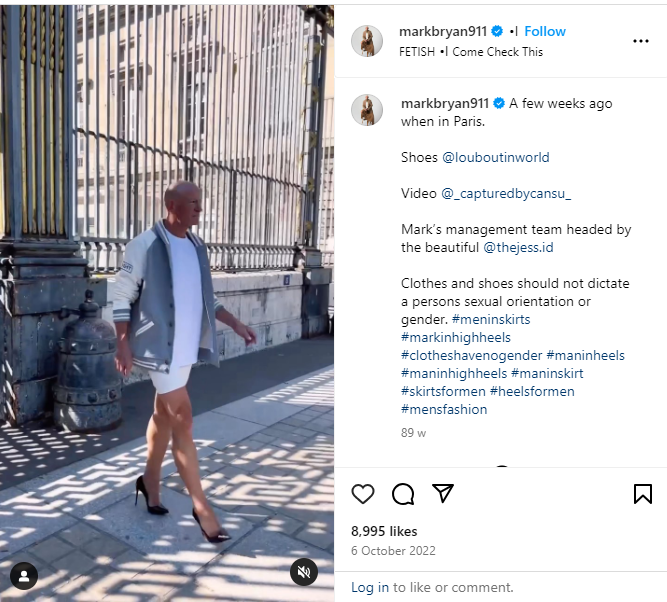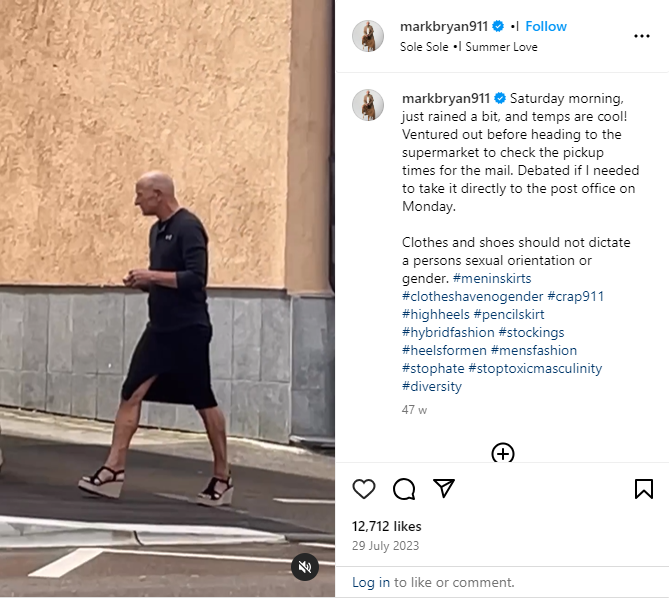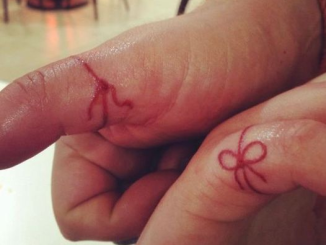
Mark Bryan is a robotics engineer who has been married for 11 years and has a daughter. He identifies as straight and chooses to dress unconventionally. Bryan is an American living in Germany, and he doesn’t believe that fashion has to be gendered. You can find Bryan wearing a skirt and heels to work or out anywhere else he goes on any given day.
Bryan said he doesn’t like how limited men’s choices are in the fashion department, especially when it comes to office attire. Men’s pants only come in a few colors, mostly black, gray, dark blue and the occasional pinstripe, and cuts.
The stylish dresser believes that if women are allowed to wear pants, men should be able to wear skirts and dresses as well. Bryan likes how skirts come in many styles and patterns – and many more colors – unlike men’s clothing.

Bryan prefers to mix traditional gender looks by wearing masculine attire on his top half, like a blazer and tie, and traditionally feminine attire on the bottom half. He will typically wear a pencil skirt and four-inch heels on the bottom.
Wearing high heels is no problem for Bryan. He first learned how to do it when his college girlfriend asked him to wear high heels while dancing with her so that they were on the same level. They continued this for over a year.
Bryan doesn’t let stereotypes or assumptions stop him from dressing in a way that brings him joy. He challenges expectations and does so unapologetically. Keep reading to hear what Bryan has to say about his fashion choices.
Bryan has a very clear idea about how he likes to dress. He told Bored Panda: “To me, clothes have no gender. I prefer skirts to dresses. Dresses don’t allow me to mix the genders. I prefer a ‘masculine’ look above the waist and a non-gendered look below the waist. It’s all about clothes having no gender.”
He continued: “I am old enough to remember that in school, the girls could not wear pants. Pants have now become a non-gendered article of clothing. So why can’t skirts and heels be non-gendered? Besides, men wore heels before women did. Maybe not today’s stiletto-style heels, but men did wear heels before women.”

Bryan is correct about that. High heels can look back on a long history. Although historians and archaeologists cannot date their invention clearly, they have been around at least since the 10th century. And they were not a fashion statement at first. No, the first recorded use of high heels was eminently practical: the Persian cavalry wore boots with heels, called a kalash or galesh, that made it easier for them to keep their feet inside their stirrups. This is, by the way, the same reason why cowboy boots have a small heel as well!
Since owning a horse was a sign of wealth, only well-off men could afford to wear these high-heeled boots. The use of them slowly spread across Europe, and high heels heels became one of the fashion signs of rich noblemen or traders. In fact, following the Great Schism of the Christian Church in the 11th century, even the pope wore high heels.
It wasn’t until several hundred years later that fashion slowly changed. During the 18th century, cultural concerns in Europe came up about the distinction between males and females and talk about what men and women should wear arose. This is the point in time where the belief that fashion is something effeminate and frivolous that “real men” shouldn’t care about hails from. Due to these changing beliefs, men largely abandoned high heels heels, as they were seen as impractical and mere accessories.

Bryan is one of the examples of how high-heels are slowly coming back as an accepted form of footwear for men. Although the engineer champions the option of wearing high-heeled shoes for men, he understands many people will look twice when they see him. He compares his style choices to someone who chooses to dye their hair bright colors. He explained:
“Take a person with bright green hair. Green hair is not normal. You look up and see this person, your mind tells you it’s a person with green hair, you think to yourself, that’s odd or interesting, then you go back to do what you were doing and don’t give it another thought. I believe this is the same when people see me in a skirt and heels.”
Bryan doesn’t have to struggle to find skirts and heels that fit him either. He wears a size 8 in skirts, and with smaller feet for a man, his shoe size in heels is 8.5. If you know a man who is considering trying out wearing heels and skirts too, Bryan suggests starting with a lower heel until you feel more comfortable walking in high heels.
What do you think of Mark Bryan’s style choices? Do you know any men who would try walking in high heels? Let us know, and be sure to send this along to your friends and family.
Céline Dion Shares a Heartbreaking Glimpse Into Her Battle With Illness
Céline Dion’s documentary, I Am: Celine Dion, has been finally released, offering a rare and candid look into her daily struggles. In one particularly vulnerable moment, Dion shares her experience of suffering a terrifying seizure that lasted several minutes.
© I Am: Celine Dion / Sony Music and co-producers
The documentary captures a tense moment as Céline Dion undergoes a medical evaluation. The Grammy-winning artist has been struggling with spasms linked to stiff person syndrome, a rare and progressive neurological disorder.
© I Am: Celine Dion / Sony Music and co-producers
Lying down on a massage table, 56-year-old Dion experiences spasms. Her doctor, Lobo, cautions that these spasms could “lead to a crisis.”
Soon after, the icon begins to experience a severe seizure. Her doctor swiftly calls for another medical team member to give her a medication used to treat nervous system disorders.
© I Am: Celine Dion / Sony Music and co-producers
At that moment, Dion can be heard groaning in pain as she shakes uncontrollably while lying face down. In a startling moment, Dion appears wide-eyed and unable to move independently.
Despite her condition, she remains conscious and manages to signal her awareness by weakly squeezing one of the medical expert’s hands.
© I Am: Celine Dion / Sony Music and co-producers
Following the administration of two doses of a nasal spray, Dion starts to recover from the seizure. The doctor mentions that if she hadn’t responded, they would have needed to rush her to the hospital.
As the My Heart Will Go On singer seems to regain her composure, she confesses to everyone in the room that experiences like these leave her feeling “so embarrassed.”
© I Am: Celine Dion / Sony Music and co-producers
Describing her horrible experience, the singer says, “I don’t know how to express it, like, it’s just … you know, like, to not have control of yourself?” Her doctor, Lobo, explains that the likely trigger for the seizure was Dion’s recent session in the studio where she had been singing, which overstimulated her brain.
Dion replied, “Well, what am I gonna do? If I can’t get stimulated by what I love, and then I’m gonna go onstage and, like, you’re gonna put the pulse oximeter on me, and you’re gonna turn me on my back?”
© I Am: Celine Dion / Sony Music and co-producers
Céline revealed her stiff person syndrome diagnosis back in December 2022. The star had to cancel tour dates in Europe, postpone her Las Vegas residency scheduled for October 2021, and later cancel her North American tour.
We admire Céline Dion’s determination and strength in the face of the formidable challenges she has encountered. Her life has been a journey fraught with difficulties from a young age, and here are seven major struggles that have shaped her into the inspirational icon she is today.
Preview photo credit I Am: Celine Dion / Sony Music and co-producers



Leave a Reply